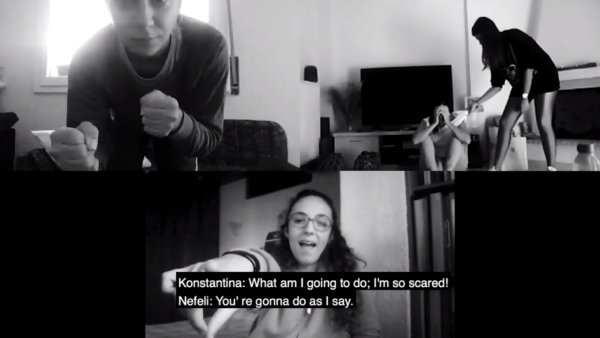OBJECTIVE OF THE SESSION
By the end of the session each member will be able to:
– Improve social skills
– Managing emotions as anger, fear or frustration
CASE SCENARIO
M is a middle-aged man, diagnosed with mental health issues, who has a poor social life and does not have many friends. He goes sometimes to a day care center, but he has difficulties with accepting his mental health issue, and that is the reason why he does not usually talk to anyone about it. However, he has recently started taking the suggested medication and he seems feeling a bit better than before. Hence, his sister manages to convince him to go out with her and some of her friends, who are aware of the man´s illness. They meet in a pub and start talking about everything and anything, laughing while sharing common daily events. However, nobody is addressing to the Man, nor taking his interventions into consideration: they totally ignore him, as if he were not there. The Man feels angry and upset and, after some further meetings with them, he tells his sister he would rather stay by himself and then he exclaims: “That is why I don´t tell people! This is so frustrating… And I will stop taking the medication: it doesn’t change anything…”
TRAINING SESSION
The trainer welcomes the participants and informs them of the case scenario (see above) either through power point presentation or via narration. After having informed the participants of the case scenario the trainer presents the goals of the session by pinpointing the type of aggression, the emotions and the coping strategies:
Aggression type
Fear of social stigma and denial of it – resulting in relational aggression and escapism from relations.
Emotions: anger, disappointment
Coping/Stressors related to mental illness/social stigma and self-stigma
Coping/Functional coping strategies
Questions and answers
1 st Question
At what point in the scenario do you find that the protagonist was a victim of violence? To
what kind of violence does the scenario refer to?
1 st Answer
The emotional violence is perpetrated by the sister´s friends during the meetings, since they
ignore and emotionally reject the protagonist.
2 nd Question
Do you think that the thoughts, the actions, the feelings and the attitudes adopted by the protagonist of the scenario helped him/her to cope with this situation? Are there any alternative ideas?
2 nd Answer
He feels frustrated, angry, upset and embarrassed and he thinks he should stop taking his medication, since it does not change the way people treat him. The fact that he does not fully accept his mental health issue does not help him, since he is the first person who negatively judges himself. He should not be ashamed of his illness and he should work with a professional on it.
3 rd Question
What other interventions and actions could further help the protagonist to deal with this incident and with any potential similar incidents in the future?
3 rd Answer
Improving self-esteem, encouraging him not to be shy and talk with people and making him understand that it is not his fault if some people ignore him or do not want to speak to him because of his illness. This is a type of discrimination due to the lack of knowledge related to mental health issues. Furthermore, he could be encouraged he should continue taking his medication since it benefits himself: he should not take such a decision because of people´ judgements or believes.
PREPARATION
These activities shall be done after some warming up exercises. This session is carried out between the trainer (improvisation professional) and the caretakers. They should all wear comfortable clothes and shoes.
- Duration: 90 minutes.
- Number of participants: 6-20.
- Place: A room where there is space to move.
- Materials and tools: Dos pelotas de distinto color.
NOTE: This session proposes a set of activities to deal with the emotions produced by verbal violence situations, some activities might be more suitable than others to the final trainees depending on factors like their culture or mental health illness (i.e those activities involving physical contact). The mental health professional leading the session can skip or modify those exercises adapting it to the needs of the trainees.
PROCEDURE
Introduction
Duration: 10 minutes.
Description: Introducing the case scenario, the questions and the emotion.
Introduction Exercises – Improvisational training
1. Exercise 1: Dancing
Purpose: loosen our body. WARMUP with music, activate the mind. Understanding the need of letting us go and do what we feel like without fearing being judged.
Duration: 10 – 15 minutes.
We’ll give masks so they can feel some kind of intimacy even if they are part of a group. We need our bodies to get ready to play.
We’ll play 3 songs. The first one will be slow, so we can stretch and ease our muscles and let our minds start to get loose. The second song will be more rhythmical. We will guide them so they can move their ankles, knees, hips, waist, arms, wrists, fingers, and neck. Once they’ve finished moving one body part at a time, we’ll ask them to try to move everything at the same time, so they start moving in an unconventional way. The last song will be very rhythmical and very well-known in your own country. Then, we’ll tell them they can move however they feel like or do whatever they want.
It’s important to remind them that they have their eyes closed, so no one is watching them move. Its important to work on those feelings of freedom and intimacy.
CONCLUSION
The final thought, which will be said out loud, has to do with the necessity of freeing ourselves, of unleashing that that we feel like doing without being afraid of being judged, because the truth is that everyone was enjoying the moment.
2. TO PLAY CATCH,
Duration: 5 minutes.
Purpose
Play and relax. Once the body has begun to take part in this experience, our mind will have relaxed a bit. When we dance, the body is free, and the mind has little or nothing to say. From now on it’s about finding body-mind balance. The classic catching game is perfect for this, as well as to laugh and enjoy.
Description
We’ll play several minutes. First, we’ll keep it simple – one person tries to catch someone else, and whoever that person catches must grab his/her catcher’s hand and form a chain, and now the whole chain will be the catcher. At the end of the game, everyone must be holding someone’s hand.
This game is the perfect excuse for physical contact. It’s perfect to get that feeling that together we’re stronger. We can get to very important and reflexive thoughts from such a silly game, even more if we’re working with people who are rejecting the group. This activity underlines the importance of group. Together we’re stronger!
Conclusion
Bring back the game and our childhood, without filters.
3. WHO’S HERE?
Duration: 15 minutes
Purpose
To meet each other. It strengthens the sense of belonging as a social being.
Description
We’ll need two balls of different colors. We’ll begin with the blue ball – we’ll say our name and then we’ll pass the ball to another person. The person that receives the ball says his/her name and passes the ball again.
Five minutes later, we’ll change the ball. We’ll use the red ball. Now, they’ll have to say the name of the person they’re passing the ball to (blue ball, they say their own names; red ball, they say the name of another person).
After five minutes, we’ll play with both balls at the same time.
It’s important to play down the notion of doing it good or bad. We keep playing while we exercise our minds
4. TELLING STORIES.
Duration: 45 minutes.
Purpose
Helping participants to identify features of them-selves. Sharing emotions.
Description
We will form pairs, and they must decide who’s going to be A, and who, B.
We’re going to give A two minutes to tell B things that are important to him/her – favorite food, whether s/he has puppies, what does s/he enjoy doing in his/her free time, what frightens him/her, what is s/he eager to do…and also what he/she thinks about the case scenario.
Once we finish, we’ll form a circle and B, who has been listening to his/her partner, will sum up everything has told him/her, introducing his/her partner to the rest of the group in a minute.
Then, everyone will go back with their own partners and start again, only that now it will be B who will be telling A all these things, and then it will be A who will have a minute to introduce their partner to the rest of the group.
Conclusion
This game’s thought has to do with those things that we keep in our minds. Our brain has to process the other person’s information very fast, so we must filter it and only keep the information we want to give to the rest.
It’s important that we do these introduction games once the session is well advanced, so no one has any kind of resistance to it. After having played for an hour, they have relaxed, and they feel like they can open up to others.
5. BEST WISHES, FAREWELL.
Duration: 10 minutes
Purpose: To have a brief meeting with each and every other participant. Closure.
Description
We walk around the room and, when the instructor claps once, they must pair themselves with someone and tell him/her what they’ve liked the most about the last game’s introductions. When the instructor claps again, we start walking again. It’s really important that they maintain eye contact with the other participants. When they hear another clap, they will pair themselves with a different person and do the same as before, until they hear a clap again. And repeat.
Conclusion
This game is about pondering how much we’ve opened ourselves to other people, about what has interested others about us, and about those feelings of playing and belonging to a group which help develop our abilities as human beings.






